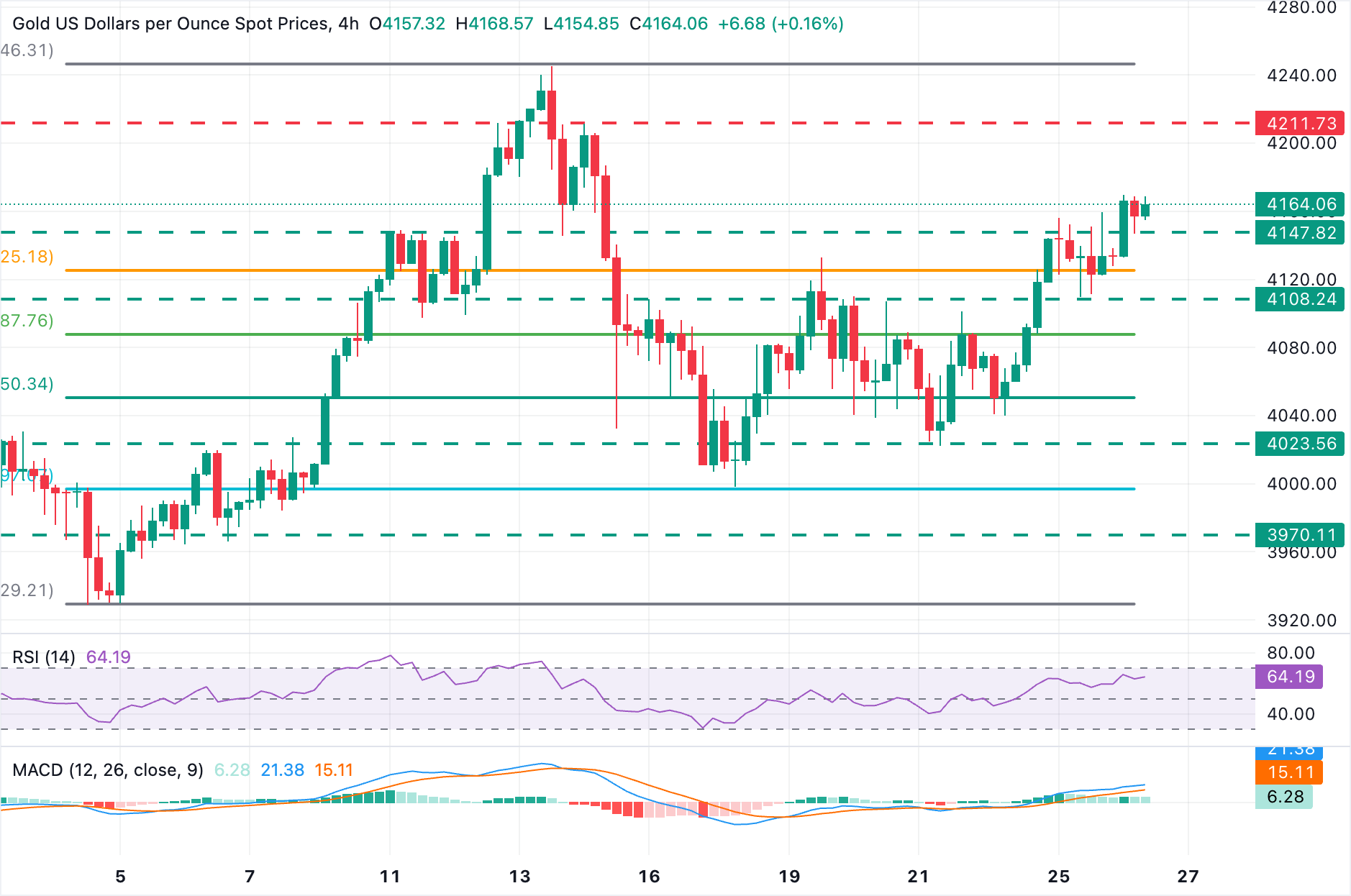Gold Price Forecast: XAU/USD holds above $4,150, with $4,210 in focus
- Gold rally extends above $4,150, and bulls eye November highs at $4,210 and $4,245.
- US Treasury yields fall for the fourth consecutive day, adding pressure on the US Dollar.
- Weak US macroeconomic data has boosted hopes that the Fed will cut interest rates further in December.
Gold (XAU/USD) remains trading on a firm tone on Wednesday, with price action consolidating above the $4,150 resistance area. Lower US Treasury yields amid hopes that the Federal Reserve will cut rates further in December are weighing on the US Dollar and pushing the yieldless Gold higher.
On Wednesday, US Retail Sales disappointed, while producer prices remained steady, and consumer confidence deteriorated. In this context, investors have ramped up bets of a 25 basis points Fed rate cut in December, which is acting as a headwind for the US Dollar, and buoying precious metals.
Technical Analysis: Above $4,150, the target is 4,210

Gold extends gains on Wednesday, with bulls trying to hold above a previous support, at $4,150 (November 14 low). The 4-Hour Relative Strength Index (RSI) stands comfortably above the 60 level, and the Moving Average Convergence Divergence keeps trending higher beyond the zero level, posting green bars in the histogram, which hints at a moderate bullish momentum.
The pair bounced from the 78.2% Fibonacci retracement of the early November rally, at $4,000, and is trending higher. The move above $4,100 confirms that the bearish correction from the November peak is over, and bulls are now focusing on the November 14 high, at $4,210, ahead of the mentioned peak, at $4,045 (November 13 high).
On the downside, the mentioned $4,150 has been providing support during the European trading session, ahead of Tuesday’s low, near $4,100, and the November 21 and 24 lows between $4,025 and $4,040.
Gold FAQs
Gold has played a key role in human’s history as it has been widely used as a store of value and medium of exchange. Currently, apart from its shine and usage for jewelry, the precious metal is widely seen as a safe-haven asset, meaning that it is considered a good investment during turbulent times. Gold is also widely seen as a hedge against inflation and against depreciating currencies as it doesn’t rely on any specific issuer or government.
Central banks are the biggest Gold holders. In their aim to support their currencies in turbulent times, central banks tend to diversify their reserves and buy Gold to improve the perceived strength of the economy and the currency. High Gold reserves can be a source of trust for a country’s solvency. Central banks added 1,136 tonnes of Gold worth around $70 billion to their reserves in 2022, according to data from the World Gold Council. This is the highest yearly purchase since records began. Central banks from emerging economies such as China, India and Turkey are quickly increasing their Gold reserves.
Gold has an inverse correlation with the US Dollar and US Treasuries, which are both major reserve and safe-haven assets. When the Dollar depreciates, Gold tends to rise, enabling investors and central banks to diversify their assets in turbulent times. Gold is also inversely correlated with risk assets. A rally in the stock market tends to weaken Gold price, while sell-offs in riskier markets tend to favor the precious metal.
The price can move due to a wide range of factors. Geopolitical instability or fears of a deep recession can quickly make Gold price escalate due to its safe-haven status. As a yield-less asset, Gold tends to rise with lower interest rates, while higher cost of money usually weighs down on the yellow metal. Still, most moves depend on how the US Dollar (USD) behaves as the asset is priced in dollars (XAU/USD). A strong Dollar tends to keep the price of Gold controlled, whereas a weaker Dollar is likely to push Gold prices up.